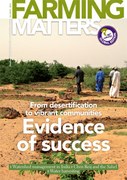Many different local strategies are being employed to combat and prevent desertification and degradation. By linking these with scientific insights relevant to the local context, the DESIRE project has identified, evaluated and tried out a set of locally appropriate land management strategies. These strategies are now being shared with a range of stakeholders, from farmers to policy makers. According to DESIRE’s co-ordinator, Coen Ritsema, “it is truly a global approach, where we look at interesting local strategies that can be expanded all over the world”.
Alterra (part of Wageningen University in the Netherlands) and WOCAT (the World Overview of Conservation Approaches and Technologies) have been running a research project on the Desertification, Mitigation and Remediation of Land (DESIRE).
From 2007 to 2012, researchers studied 17 desertification hotspots around the world, covering a wide range of problems, from soil erosion by wind or water to salinisation and droughts or flash floods. “Scientists and land users worked together to deliver a tangible product”, explained the DESIRE co-ordinator, Coen Ritsema.
At every study site, researchers discussed the contextspecific problems with a variety of stakeholders. They then proposed a number of scientifically developed solutions, which might complement the experiences of local land users, and gave land users the choice of testing the most promising strategies. Many, if not most, opted for conservation agriculture techniques.
“Unsustainable, expensive and polluting strategies are rarely selected by land users,” said Mr Ritsema. The strategies were then jointly evaluated. Increased productivity was not the only criterion for evaluating these strategies; their impact on people’s livelihoods and in preserving local and regional ecosystems were also considered. “We evaluate the revenues, but also the costs and benefits: the activities have to be interesting to land users in terms of costs as well.”
The outputs of the DESIRE project are freely available online in the multi-lingual DESIRE Harmonized Information System (www.desire-his.eu). On this website, the research programme and its results are available in a variety of forms. Visitors to the project website (www.desire-project.eu) can download the practice-oriented book Desire for greener land, which explains the methodology of the study and all the strategies tested at the study sites.
Knowledge sharing was an important component of the project. The results of the local assessments, including benefits and costs, have been translated into different communication packages, ranging from simple posters and brief information sheets to videos, technical reports, policy briefs, step-by-step guidelines and a book.
“The database of strategies has an enormous educative value. Of course, what works in one area will not be successful per se elsewhere. We are creating a basket of options, from which land users can choose, and they have to test what works in their own area on a trial and error basis.”
Successful interventions can only be effective on a larger scale if they are shared with practitioners, extension services and policy makers in other regions. “We have created white papers and policy briefs for national and international decision makers, giving them ammunition for their policies. We also offer simple and informative leaflets in a format that is understandable by land users.”
The DESIRE approach has already been incorporated in publications and initiatives by the United Nations Convention to Combat Desertification (UNCCD), FAO and the Global Environment Facility. Now, the project will focus on creating an interactive online tool to make all the possible strategies even more easily visible for the end users. “We can share with a wide audience that there are available solutions to degradation!”
Text: Laura Eggens

